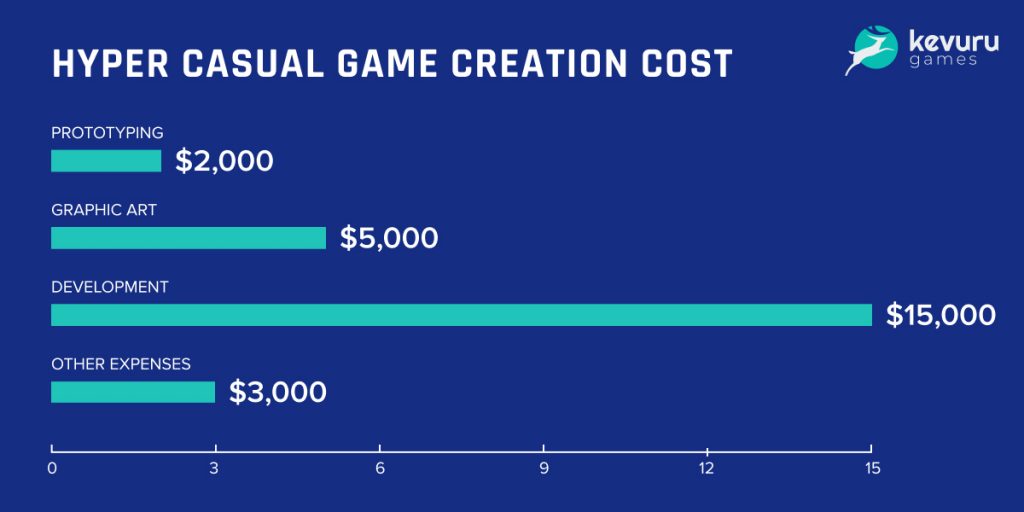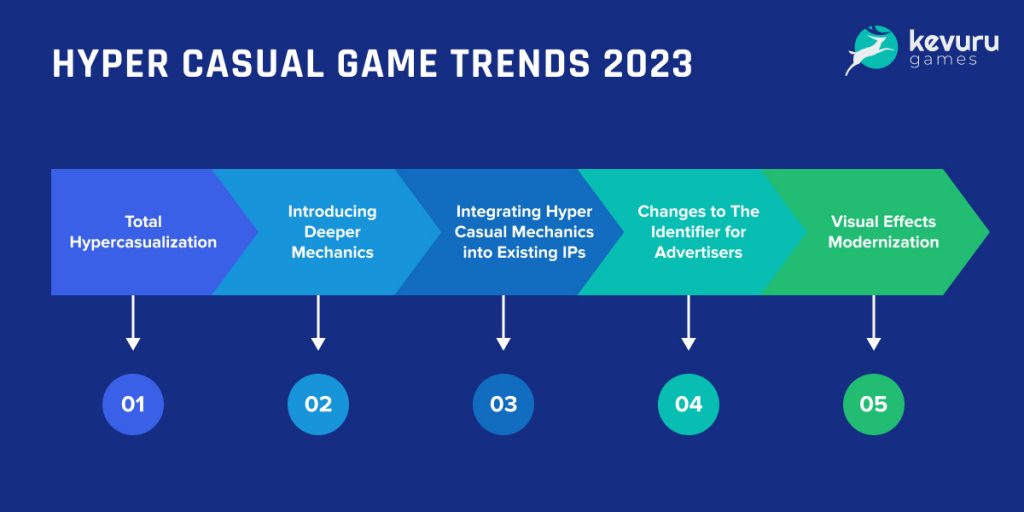Hyper casual games burst into the gaming market and quickly demonstrated the absolute competitive advantage of elegant simplicity. The term itself began to be widely used in mid-2018, when the bouncing ball game with rotating towers Helix Jump blew up the mobile market and became the most downloaded game of 2018 with 334 million downloads, overtaking Fortnite and PUBG. Coincidence or not, the rise in popularity of this game just preceded the emergence of the new term hyper casual game in the lexicon of game designers.
In 2019, hyper casual games showed who was the boss:
- According to Sensor Tower, 77.6% of the 2.1 billion installs of the 20 most downloaded games released in 2019 turned out to be hyper casual games.
- During the 2020 pandemic, hyper casual games continued their triumphant march – the number of installations worldwide more than doubled (103%), and the number of sessions also increased approximately.
- Compared to December 2019, when there were already more than 1 billion sessions, the number of sessions in hyper casual games in March 2020 increased by another 72%.
In 2022, hyper casual games continued to grow:
- Hyper casual games were downloaded 4.4 billion times through the App Store and Google Play in the second quarter of 2022. This is 10% more than in the second quarter of 2021.
- In the second quarter of 2022, hyper casual games showed a 2.3% increase in revenue to $27.3 million.
- Hyper casual games ranked first in terms of downloads in H1 2022, generating 718.2 million installs.
Now opinions are divided. Some believe that in the current year, they will continue to storm the heights of App Store and Google Play, while others are inclined to think that the market is already oversaturated and their popularity will soon fizzle out. We believe that there is no reason to diminish the impact of hyper casual games. And even if we assume that the story of the pandemic is over (we hope so), we will not get rid of the need to spend time on the road, waiting for an order, or hanging out during other breaks between various events.
Today, we’re not just here to understand how to make hyper casual games. We aim to tell you how to create a hyper casual game that will stand up to the competition and bring you great revenue. Ready to dive in? Then let’s go ahead and let our path to the featured lists of Google Play and App Store be direct, short, and fast.
A Hyper Casual Game: Definition
These games can be summed up in one expression – “Play as much as you want, whenever you want!”
So what exactly are hyper casual games?
A hyper casual game is a simple game with elementary mechanics, rich visuals, minimalist design, and addictive gameplay.
This type of game is popular due to:
- short time to complete one session – on average, it’s 3-6 minutes;
- instant immersive gameplay;
- very simple, repetitive player action mechanics;
- no time limits unless the mechanics allow for it;
- no tutorial – everything is intuitive;
- almost instant transitions to new levels.
All hyper casual games have the same key features, whether it’s a match-3 game or an endless runner. At the same time, seemingly countless hyper casual game ideas ultimately boil down to one – to offer players an instant opportunity to start the game immediately after downloading from the store. There is no need to log in, register, or create a character – just click Play and start completing the levels.
While focusing on simplicity, it is important not to forget development. This is not about changing or complicating controls or functions. Assuming the player is already used to performing the necessary actions, you can:
- increase the pace of the game;
- reduce the time to complete the level;
- add more obstacles or enemies;
- reduce the amount of resources needed to complete a level, etc.
Doing the same things, but more dexterously and skillfully – that’s what we can offer players in terms of development so that they do not get bored even during the second or third game cycle.
A Genre or Not a Genre, That Is the Question
What are hyper casual games in terms of genre? Are they a subgenre of some popular genre?
No.
Hyper casual games are not a new genre, and indeed they are not a genre at all.
This is the designation of a certain game category, characterized by a similar audience, monetization models, and long gaming sessions – the same designation as casual, mid-core, or hardcore games. At the same time, it is sometimes difficult to determine the exact boundaries of all these categories.
We can highlight such key features of hyper casual games:
| Instant access to content | No plot inserts, preloading, level selection, or lengthy tutorials. Players immediately find themselves in the epicenter of the game. Thanks to the uncomplicated gameplay, not overloaded with details, the player can figure out what is happening in just a few seconds. More precisely, 5 seconds after clicking on the game, the player should already be playing. And a short game cycle allows you to play without waiting for a long load, anytime, anywhere. |
| Increased attention | Such games do not provide an opportunity to doze off – they need all the attention of the players here and now, without being distracted by external factors. If a player gets carried away, it immediately leads to defeat. Intense concentration gives special satisfaction at the end of the game cycle during relaxation. |
| Replayability and repeatability | Infinity is the key to success. This game has no end as such, the player can start replaying at any time, setting records and trying to improve time and points. The player should not be bored at any stage, so the game should have enough attributes to ensure continued enjoyment. |
| Minimalism in gameplay and design | The gameplay is often as simple as possible. The rest of the components of the game correspond to it. The visual component, control, and sound – nothing should prevent the user from fully concentrating on the gameplay. |
| Simple monetization model | The game does not encourage players to pay for content; instead, they pay with their time. More than 70% of the game’s revenue comes from advertising: banners, video ads, rewarded ads, etc. We’ll talk more about this a little later. |
Hyper Casual Game Design Features
Even though there is a lot of information on this topic, many still try to clarify an important detail of hyper casual games – how to make visuals that make the game stand out from others, while at the same time remaining true to the key characteristic of simplicity?
Hyper casual games tend to have a minimalist and attractive design to further engage the user. In addition, they offer progressive and fast gameplay so that the person wants to keep playing for as long as possible. To achieve this, games need an eye-pleasing design with a simple and fluid color palette, beautiful geometry, and ample white space between assets. This is a kind of gaming feng shui – you optimally master the space, avoiding excessive complexity and piling up of elements.

Additional hint. If you are interested in how to make a hyper casual game for a wide range of people, and not for niche connoisseurs, then refer to topics that will be relevant to different cultures and nationalities. Win-win options are animals, food, sports, transport, as well as impersonal variants such as pure geometry and well-known shapes and actions.
Hyper casual games are not an option where you need to work out characters and draw complex backgrounds. There are often no characters here. The player is left face to face with some object offering to perform one or two actions. There is nothing else here, and it is perfect within this category.
Tap to dodge, swipe to shoot – these are the best tutorials you can offer the player. Sometimes even these words are not needed – it is enough to throw the player into the gameplay, which is very easy to master through trial and error.
Remember, you have 5 seconds to convince the player that the game is interesting and worth playing.
Basic Mechanics For Hyper Casual Games
Considering the question of how to make hyper casual games, it is impossible to bypass the question of mechanics. Everything is built around it. Often, developers take one or two mechanics – more leads to the complexity of the gameplay and violates the concept of maximum simplicity.
In terms of mechanics, the following options are the most popular for hyper casual games.
Rising/Falling
This mechanic encourages the player to contribute to the rise or fall of an object or the entire environment. To complicate the process, it is also possible to increase the speed or the number of obstacles. The player can manipulate both a specific object and the entire level in the form of a platform or wall. The main feature of this mechanic is a distinctive sense of gravity that will follow the player throughout the entire game session.
Tap/Timing
The meaning of the mechanics is to have time to touch the screen in order to perform a specific action. A natural complication would be to increase the speed and encourage the player to touch the screen more often and more accurately. For example, here you may need the optimal time to jump or hit the ball. This is often done through a shrinking window of opportunity with a clear distribution of favorable and unfavorable zones for action. If you miss a moment, you have to wait for the next opportunity.
Dexterity
Also known as agility game mechanics, this is sometimes confused with timing games. But if the essence of time trial games is to hit the screen at a specific moment, here the key action must be constantly repeated at a gradually increasing speed. The more agile the players perform the action, the higher the score they will receive. Because of the emphasis on dexterity and the need to develop it in order to progress, the mechanics got the appropriate name.
Merging
The essence of the merge mechanism is to find similar objects and merge them to get a new, improved object. It is important to understand that players can only merge items that are similar in certain parameters, and those that have significant differences cannot be combined. After a successful merge, the resulting element is used for a specific game purpose, such as a race. The better the merge options you choose, the more likely you are to win the race.
Stacking
This mechanic allows the player to stack objects. It is also possible to rotate or turn them, which can serve as a kind of complication. The higher the level, the more complex structures the player will have to stack. Suffice it to recall Tetris – the player manipulates the geometric shapes falling from the sky to match them and thus clear space for the next shapes. But it could be something even more interesting. For example, cats.
Turning
Turning left and right is all that is required of the player. Usually, these games are 3D, and this can make the game more complex. So it is very important to provide simplified controls to maintain the classic hyper casual style. This is either a single hit on the screen in the right place or a sharp swipe in the right direction. The location of the camera is also important – the farther it is, the more time the player will have to prepare for the turn. Keep this in mind to gradually complicate the levels, but don’t overdo it. Find the right balance.
Growing
Here, the mechanic requires the player to gradually build up the object by absorbing others. Everyone knows the classic Snake, where the snake eats objects and becomes longer and more difficult to control. Moreover, the speed of its movement gradually increases and, accordingly, the player’s tension does. This is one of the simplest and most addictive mechanics, which has repeatedly proven its worth and advantage over others. It is as simple as possible, keeps the attention of the players at all times, and encourages them to keep playing to see the maximum length they can grow their object to.
Swerving
Often confused with turning mechanics, it means constantly maneuvering an object without lifting your finger from the screen. The more difficult the level, the higher the speed, the more obstacles and turns. The key is how the skid will be on the next turn and whether players will fly off the track. In some games, flying off the track can be a kind cheating and shorten the distance to the finish line.
Resizing
The task of such a game is to constantly decrease or increase the size of the controlled object in order to crawl through some holes or fill in some gaps. This must be done before the moment when the object approaches the control point, where it should already have a different shape. The mechanics are partially similar to the swerving options but offer more room for imagination and creating something unique.
Pushing
The goal of the players is to push objects, structures or other characters faster than they can push the players themselves. As a result, the player must remain alone on the map, and this will mean victory. It is important to provide the player with free movement of the character and more or less suitable physics. The game can be made more difficult by increasing the number of objects and enemies that need to be pushed out and the appearance of additional obstacles that complicate this task.
Puzzle
Although it is considered a separate genre, it is also relevant for hyper casual games. The player is encouraged to place items in the right places, customize the pipeline, or paint over a specific space with a limited number of strokes. The complication here is implemented by an increase in the number of necessary actions to complete the level and the need to think through the actions more carefully. There is often no time limit here. This allows players to think calmly, without stress and rush.
Direction
These games often ask the player to remove obstacles in the way of a character, object, or flow. When obstacles are removed or the system is adjusted appropriately, players see objects or liquids moving towards their destination. There are different options here – you can offer the player both to remove objects from the path, and to control the level itself and its constituent elements in the form of slats, walls, and other things.
Monetization: How to Create Hyper Casual Games That Bring Profit
Fun fact – hyper casual games are usually free. Many of them don’t even offer in-app purchases. In this case, you are asking how much money do hyper casual games make and how does it even happen?
In-game purchases are usually relevant for so-called hardcore games, where players spend a lot of time, where there is a large game world and a huge number of gameplay features and alternative story options. Players are ready to invest in large-scale games, the plot and intrigue of which captivates them for hundreds of hours.
But in-app purchases are not suitable for hyper casual games.
Moreover, with persistent recommendations or frequent mentions, they can annoy and provoke a person to delete the game forever.
But you have some ways out:
- in-app advertising – ads that rotate in the game between different levels;
- payment for the premium model – an investment that allows the player to get rid of all ads at once;
- cross-promotion – ads for one game that appear in another game.
The most popular option is advertising. It works much faster than in-app purchases and can be very variable. There are 3 main types of ads in hyper casual games:
- Rewarded video ads. As the name implies, watching such ads gives the player some kind of reward: extra hit points, in-game currency, or a special one-time-use skill. Players are ready to make such a deal, which also increases session duration and retention.
- Banner ads. Banners are very easy to add to the game – they are great for single-screen ones since it is easy to allocate part of the screen for advertising there. Banners are shown right during the game, but do not interfere with it.
- Interstitial ads. These ads take up the entire screen and can be static or dynamic in the form of videos, geolocation guides, or playable content. It is important to properly test the pros and cons of skipping such ads, as they interrupt gaming sessions and do not offer any reward in return.
It’s hard to say exactly “how much do hyper casual games make?”. But you can do your best to maximize their potential profit.
A great way to optimize ad revenue is to learn about user data and adjust the monetization method that users interact with the best.
If the player is not engaging with rewarded ads, show them more banners and interstitials. If they interact more with banners and interstitials, show them fewer rewarded ads. It is important not to bombard players with all sorts of ads, but to adapt their display in accordance with human behavior. Personalization works great everywhere, and in this case too.
How Much Does It Cost to Create a Hyper Casual Game?
Everyone always wants to know the exact price and constantly rolls their eyes when they see the words that it depends on many factors, etc. Although it really depends on many factors, in particular the level of game mechanics and graphics, one thing is for sure – hyper casual projects will cost you much less than other types of games.
First of all, this is due to the fact that to create a hyper casual game, not as many specialists are required as, for example, for the AAA project. Enough for 1 person from each direction: game designer, 2D/3D artist, developer, UX/UI designer, and sound designer. Of course, a project manager is also needed to coordinate all processes.
The term for creating a hyper casual game is from 1 to several months, depending on its complexity. Approximate stages look like this.

- Prototyping. With the help of a prototype, you can assess the viability of the game, test the appeal of its main mechanics, and see if it makes sense to work on it further. Or you need to modify or redo something. It can take several days and costs around $2,000.
- Graphic art. At this stage, all artistic and graphic elements for the levels, menus, and interface are created. The approximate time frame is a few weeks, so prepare about $5,000.
- Development. Developers are on the task of making your game playable. They implement graphical integration, introduce game mechanisms, and all conditions are worked out. The term varies within a couple of months, the cost will be about $15,000.
- Other expenses. Do not forget about the need for music, testing, and coordination of the services of project managers. Quality checks can take a couple of days, and sound design can take about a week. Set yourself up for an additional cost of around $3,000.
So, we answer the question of how much does it cost to create hyper casual games – that’s about $25,000 excluding marketing. If you are planning an active advertising campaign, then be prepared to spend about half the budget allocated for the creation of the game itself.
5 Hyper Casual Game Trends to Expect in 2024
Hyper casual games remain one of the fastest-growing areas of mobile gaming. We explored what to look for when creating and reviewing projects in this category this year.

1. Total Hypercasualization
Today, developers are ready to implement almost any mechanic and idea in the form of a hyper casual game. Some borrow mini-game mechanics from console titles, some bring action from real life to the game, and some adapt choice-based games to hyper casual style, such as Save the Girl and Chat Master.
2. Introducing Deeper Mechanics
Unlike the first trend, other developers will try to combine the gameplay of mid-core games with hyper casual mechanics. This can lead to the creation of new subgenres with simple appeal but richer content. This can already be seen in the game Ancient Battle, which combines strategic and hyper casual mechanics.
If this trend continues, hyper casual projects may stop forgiving players and return to their roots, becoming more demanding on the skills of users.
3. Integrating Hyper Casual Mechanics into Existing IPs
In 2020, only 5% of hyper casual games were based on third-party IP. The situation began to change – the famous American online game developer Zynga acquired the Turkish studio Rollic, MY.GAMES invested in the hyper casual publisher Mamboo Games, and many other similar deals took place. The symbiosis of big publishers with hyper casual developers can lead to the creation of games based on big franchises in the hyper casual market.
At the same time, adding hyper casual mechanics to existing IPs will help companies expand the audience of their projects. This approach can also become an entry point into the gaming market of big-name brands, as has already happened with the adventure and puzzle genres, for example, with the well-known IPs like Frozen and Harry Potter.
4. Changes to The Identifier for Advertisers
The Identifier for Advertisers (IDFA) is a unique number that Apple assigns to each device. Changes to IDFA rules can change the hyper casual market as they are closely related to ad monetization. The specific implications will depend on how innovation ultimately works and how publishers are able to adapt to it.
Some experts speculate that hyper casual games will have an edge due to their large user base. This will allow publishers to promote games in other projects of their portfolio.
5. Visual Effects Modernization
Hyper casual games are often found by social media users in the form of ad creatives that are mini versions of the game. Therefore, the priority will be more interesting and original creatives. You can even talk about a few strange, incomprehensible and even awkward visual effects that cause ambiguous emotions, but arouse interest.
The graphics will become more advanced, modern and realistic – the player will no longer be surprised by the standard cartoon visuals. With the development of technology and changing user requirements, more complex projects from a visual point of view will appear on the market.
How to Choose a Hyper Casual Game Company?
It seems so easy to build a hyper casual game. But this external simplicity includes:
- carefully thought-out strategy;
- re-tested mechanics;
- captivating storytelling concept;
- a huge amount of work to bring all the elements into a coherent and harmonious picture.
It’s not enough just to copy someone else’s idea and make a slightly different design. In most cases, you will come across just such an approach. Hyper casual games are very popular, there are a lot of them, and every year it becomes more difficult to offer players something fresh and not repeating others.
When choosing a company that offers services for making hyper casual games, first of all, pay attention to whether there are similar projects in its portfolio. Studios that have not done this before are not the best choice, especially if they say that there is nothing difficult here even without experience. It is highly likely that they will not be able to identify your target audience, interest it with exciting mechanics, or find a successful hook to stand out from the millions of similar games.
At Kevuru Games, we know how to build hyper casual games that will grab the attention of players. And the attention of the players is what makes the game successful and helps you recoup the costs in the very near future. We:
- monitor the latest trends;
- pay attention to the preferences and interests of players;
- immediately implement the most advanced techniques and mechanics that appear on the market.
Games created with us are always bright, interesting, and memorable. We will guide you through the crowded environment of hyper casual games and help you present your project in a way that will delight your target audience.










